Real-time marketing – definition
Real-time marketing, real-time marketing or RTM is the art of responding quickly and brilliantly to current events. In real-time marketing, brands build communications based on current events or, less frequently, dynamically developing trends. The hallmark of real time marketing is that the response should be almost instantaneous. As soon as something noteworthy happens, the brand must be ready to create and publish relevant content that links to it.
What are the qualities of an event worth addressing under RTM?
First of all: it has to be something that happened now, at most a few hours ago, although in many cases and such a delay can derail the chances of properly exploiting the situation.
Second: the event must be properly recognized – no one creates RTM content based on a statement made by the vice president of a local fishing club – unless that statement goes viral.
What is viral? It is usually a video or audio recording, but also a meme or post in text form, whose popularity has grown exponentially in a short period of time, often achieving results that are difficult to predict. The hallmark of virals is that they are transmitted between users from the bottom up – most often through social media.
Third: it doesn’t really matter what the event is related to – as long as it is popular. It can be a sporting event (like the recently concluded Olympic Games), a political event (the U.S. presidential debate), a cultural event (the premiere of a high-profile movie) or a showbiz-related event (an incident at an awards gala).
Important!
RTM is not exclusive, but only ancillary – no brand would be able to create content consisting entirely of references to the hottest news stories, especially since the “shelf life” of these events is usually very short, and only a fine line separates an excellent RTM from a failed attempt to “tap into” an already tiring trend.
What is not RTM?
Real time marketing must contain an element of spontaneity – it’s a reaction to something unforeseen, so we won’t call real time marketing:
- post on the occasion of Valentine’s Day, Children’s Day or any other calendar holiday,
- graphics alluding to the mere fact of winning or losing a sporting event – which is different if the match was laced with some special gesture, broken record or other element that made the event stand out.
In short: real time marketing cannot be planned. The moment a brand prepares for an event in order to respond to it appropriately, the activity no longer meets the definition of real-time marketing.
Important!
A reference in the content of a post to a cyclical holiday or other recurring occasion will be called contextual marketing – all Easter publications fall into this category.
So it won’t be a classic RTM reaction to the Polish volleyball team’s Olympic medal, since winning the medal was already certain a few days before the final match. A suitably brave brand could, however, try to capitalize on an uncharacteristic statement by the Polish national team’s host Tomasz Fornal, who in soldierly terms cheered his colleagues to victory in the semifinal match.
The difference between the two events is clear – the latter no one could have predicted, including the author of the quote himself.
Here’s an example. On the left, we have clear contextual marketing – content prepared for the recently concluded Olympic Games. This material could have been prepared in advance, and its shelf life is as long as the sporting event lasts. What’s more – the same graphic can be successfully used four years from now as well, since its message and “ingredients” are unlikely to change.
On the right, on the other hand, we present a model example of real time marketing. IKEA showed a post that refers not to the Olympics in general, but to a specific event. It is about interviews given by athletes complaining about uncomfortable conditions in the Olympic village.
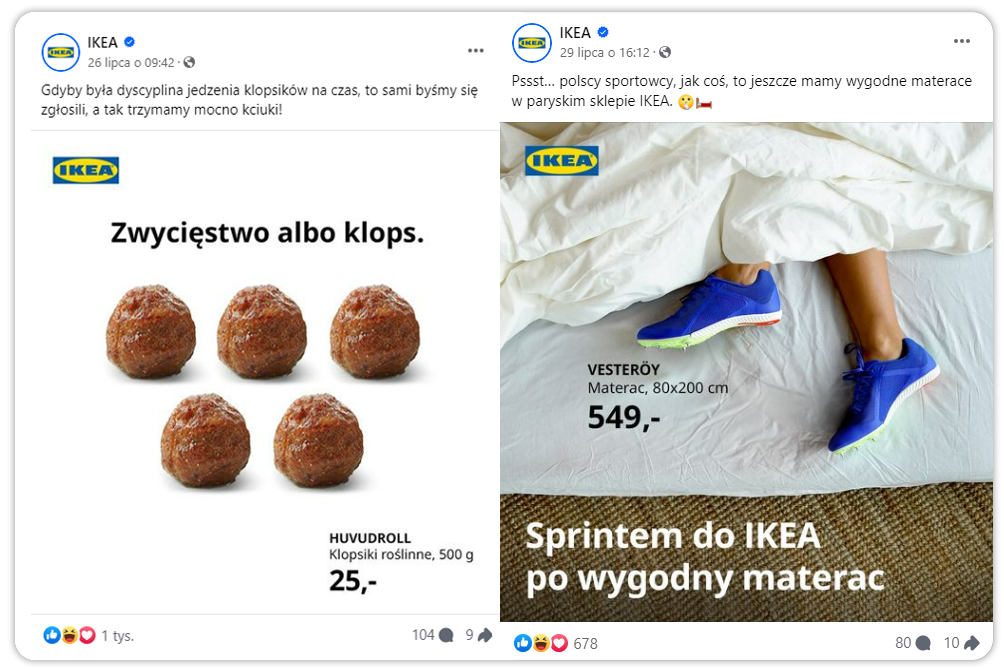
Potential benefits of using real time marketing
High-profile events provoke discussions, inspire memes, shorts and witty comments, and, above all, create coverage. As a result, RTM is one of those activities that – with relatively little effort – can bring unexpected benefits.
Commenting on an important event in a witty, often humorous way can result:
- coverage in the millions,
- Increased observer engagement,
- many interactions,
- Increased brand recognition.
However, the large reach of a post can prove to be a double-edged sword – many people’s eyes will turn specifically to your brand, and they will observe how you are doing online for some time. What’s more, some Internet users may also want to track your brand’s previous social media activity – there’s nothing surprising about this, but it’s worth taking into account.
What matters a lot is how you respond as a brand. In some industries, what you actually respond to is also important. When trying to gain user interest, keep in mind your target audience – your current and potential customers.
And here is another example! On July 20 this year. the world heard about Microsoft’s global service outage. The most noticeable effect for many consumers – especially during the vacation season – was thousands of canceled flights. The Windows failure also affected banks, health care facilities and many businesses. The X-kom store decided to react to this, promptly posting a funny graphic featuring the three brand logos behind the most popular operating systems. In place of the Windows logo was an error screen (the so-called “blue screen”).
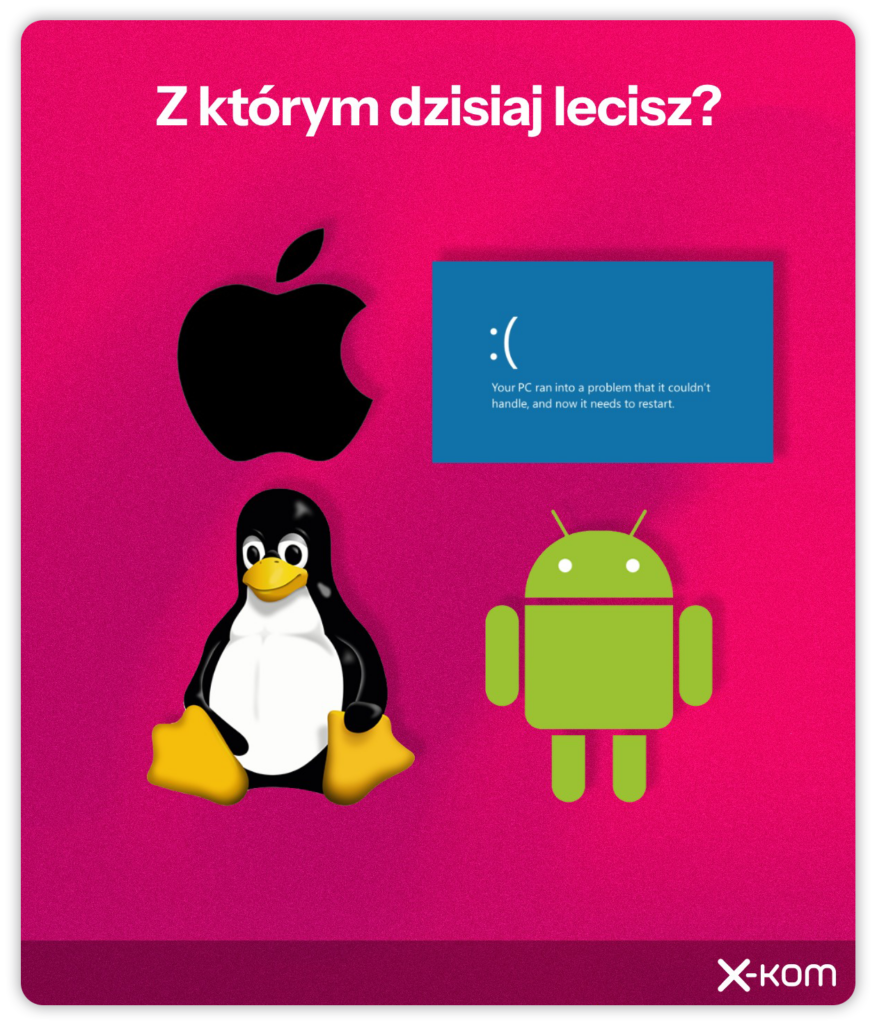
How do you prepare for real-time marketing?
A few paragraphs earlier, we wrote about how RTM content planning actually conflicts with the idea of real-time marketing. But now we want to talk about what you can do so that you don’t miss the opportunity to apply RTM. How do you combine one approach with the other?
Yes, in the context of real time marketing one can talk about strategy. However, it’s not so much about preparing ready-made content or reaction schemes in case something appropriate happens, but about constantly keeping your hand on the pulse and creating an internal communication channel where those responsible for marketing the brand can inform the others about events worth reacting to.
The basis of proper preparation for RTM activities should be monitoring the Internet. This keyword includes checking hashtags, creators and content gaining popularity on social media, observing spaces where viral content is created (in recent months mainly TikTok), but also high-profile events with the potential to be used in real-time marketing (for example, major sports or cultural events).
Real time marketing in practice – does it always make sense?
Although it’s difficult, because there is usually little time to react, each time before preparing and publishing RTM content, ask yourself: will this help my brand?
For a real time marketing activity to make sense, it should evoke positive emotions, influence brand recognition (in a good way), engage users and stand out in some way. RTM should also relate to your brand’s products or services in any (even loose) way. While the goal of real time marketing is rarely to make a sale (moreover, a focus on that goal can harm a message that turns from a sincere, entertaining post into an attempt to make money directly), that doesn’t mean it should be forgotten.
When can RTM sell?
A perfect example in this case is IKEA, which appears in almost every article treating real-time marketing. But what to do – the Polish branch of the Swedish market has been presenting a very high level of content for years, and real-time marketing is one of the most relevant and distinctive types of activities undertaken by the brand in social media.
IKEA is not just a furniture store, but a place where you furnish your home down to the smallest detail. The store’s assortment is so wide that matching any of the brand’s products to high-profile events is simply much easier than – for example – for a manufacturer of electric heaters.
However, if your brand has products or services that naturally correspond with current trends, don’t hesitate to use them!
Here’s another example. Shortly after the premiere of the Wednesday series, the Internet fell in love with the Hand, the conscious, living hand that accompanied the main character on screen. IKEA’s flawless marketing department seized the moment as well:
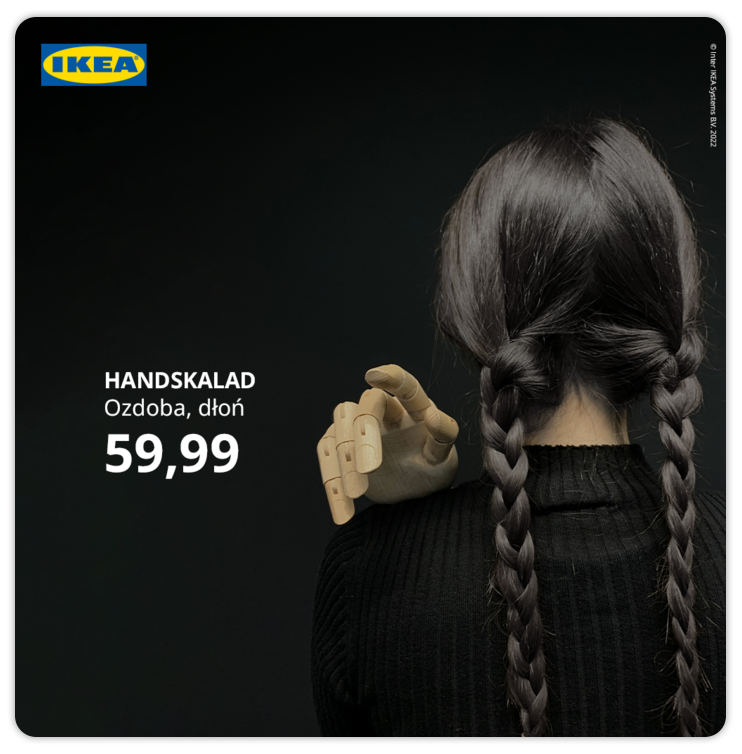
Did sales of the HANDSKALAD product increase? We don’t have such information, but even if not – the creation has brought the brand positive reactions, publicity and even more love from Polish consumers. And all of this can be much more valuable in the final analysis.
Other examples of real time marketing
Sports and cultural events unite people, but also provoke discussions – often very heated ones. However, the cause for real time marketing can also be smaller events, such as… a mistaken message sent in an app to bank customers. Here are some examples of real-time marketing in which brands have decided to join the suddenly exploding trend.
Series “4070,” directed by x-kom
This was also the case with the premiere of the series “1670” on the Netflix platform, which caused a lot of discussion on the Internet. Overall, however, the series turned out to be quite a success and became very popular. The situation decided to take advantage – again – of the X-kom store. The marketing department decided to present the flagship product from its offer – one of the most powerful graphics cards, GeForce RTX 4070 on a graphic that refers to the style of medieval painting, and garnish it with a funny caption, using the numbering of one of the previous models of graphics cards from the same manufacturer:
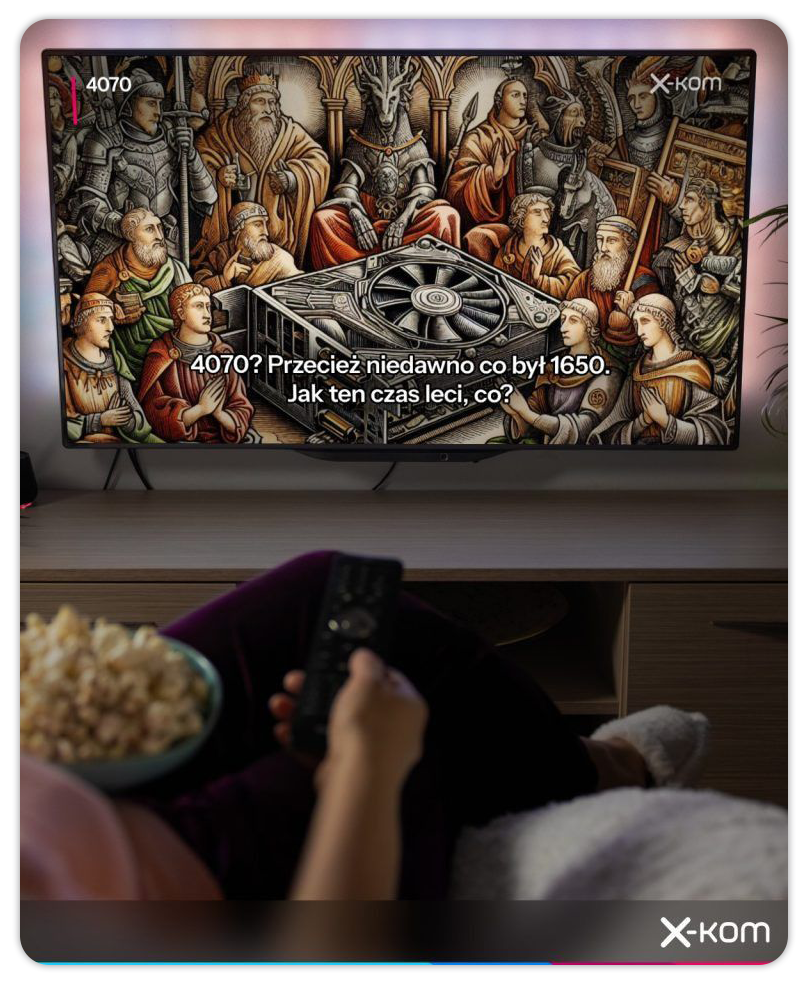
2 billion reasons
In 2022, the merchant ship Felicity Ace caught fire in the Atlantic. Although the information itself is definitely not positive, the attention of Internet users was drawn to the fact that the staff of tvp.info decided to annotate the text with a thumbnail consisting of two photos incompetently connected to each other. The Internet was almost immediately flooded with a wave of rewrites, and Wolt also decided to attach his wagon to this peculiar train. The food provider posted a deliberately inaccurate graphic, and in the content of the post alluded to the controversial funding that state television and its subordinate services have received in recent years.
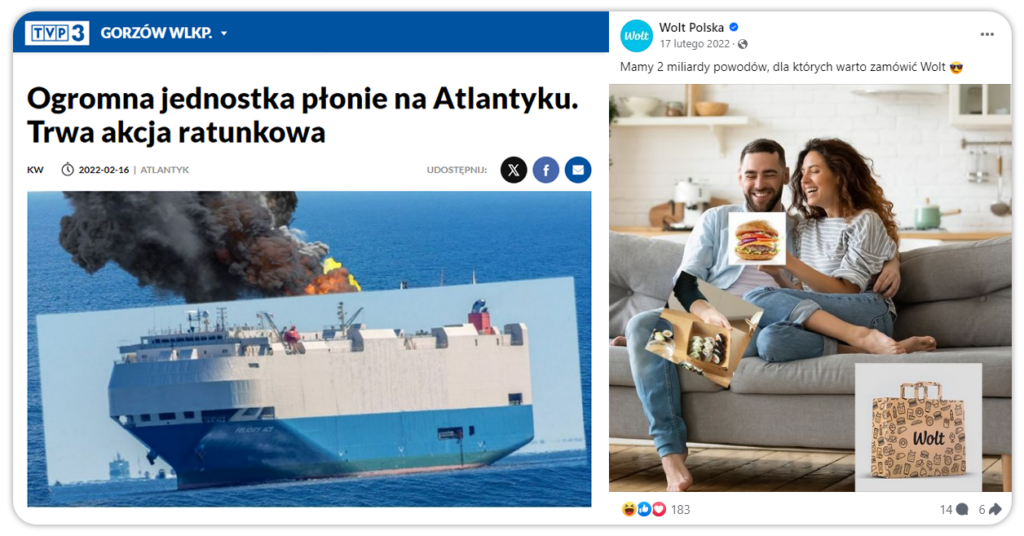
“ę¿”. One word – thousands of publications
A few years ago, mBank customers received a strange notification in the bank’s app. The content of the notification was “ęśąćż” and was intended to test how Polish characters are displayed in the app. Someone mistakenly sent the message not on the test platform, but immediately to all the bank’s customers. Internet users immediately picked up on the situation. One of the graphics creators – Fakes Forge – even prepared an updated logo for the bank. The creation was so well liked that mBank itself used it as its profile picture.
The distance with which the company approached the situation won it the favor of consumers. The post with the profile picture change alone generated more than 30,000 reactions, nearly 2,000 comments and 1,500 shares.
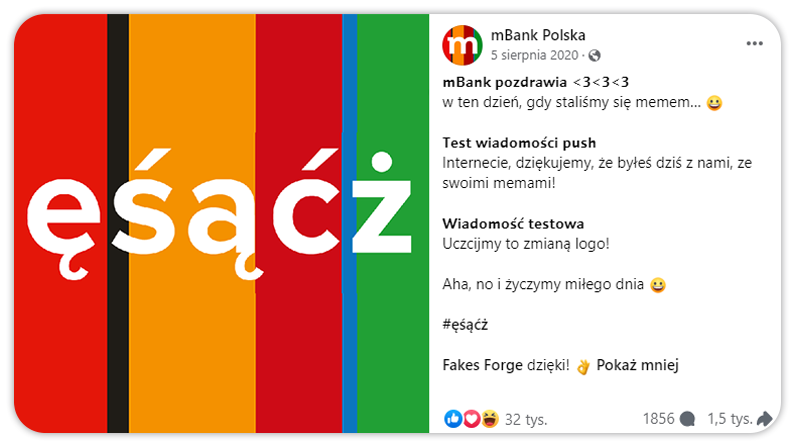
Other brands – such as Allegro – also reacted to mBank’s mistake. Allegro’s creation, moreover, shows that sometimes it really doesn’t take much to take advantage of an emerging opportunity:
Summary
Real time marketing is a strategy that can benefit a brand in many ways. The key to success, however, is a combination of three things: immediate response, sensitivity and… humor. RTM activities are almost always created with the aim of eliciting a positive reaction – it’s worth following that lead.
However, real-time marketing is not a good solution for every brand in every situation – the ideal situation is one where you can match something related to your company to an event you want to comment on appropriately. It doesn’t necessarily have to be a product. A similar color scheme, place of action, and sometimes even a name coincidence or other seemingly minor element will also be suitable.


